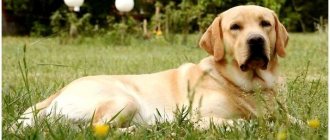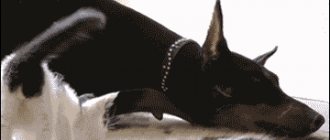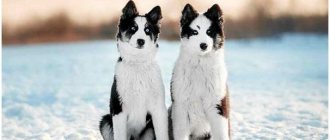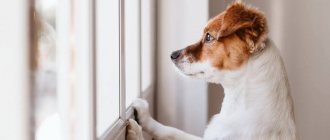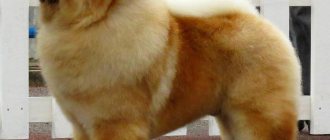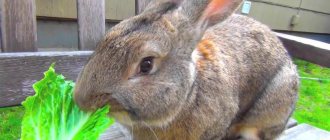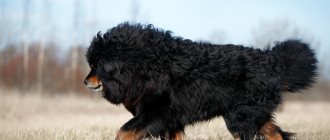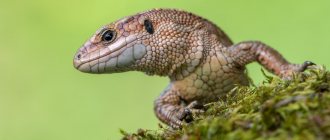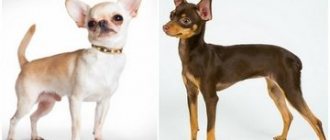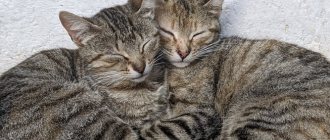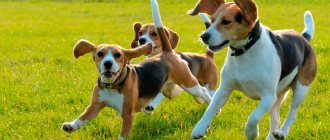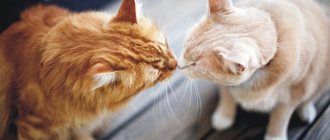The Standard German Pinscher is an energetic and cheerful dog that is very loyal to its people. It has strong protective qualities and is perfect for people as a companion dog. A clear disadvantage of the breed is intolerance towards other pets.
Let's look at other character traits of the German Pinscher, as well as breed standards and rules for caring for them.
Standard German Pinscher: history of the breed
This is one of the oldest breeds in Germany. It is believed that it originated during the Middle Ages from German turf dogs. Initially, standard German pinschers worked with grooms, assisting them in accompanying animals and catching rodents.
Later, the Pinscher breed received 3 varieties depending on the size of the dog:
- miniature pinscher;
- standard;
- big (became a Doberman).
Since the 19th century, in Germany, representatives of the breed are divided into long-haired schnauzers and smooth-haired pinschers. Each variety has its own standards.
This is interesting! The breed was officially recognized in 1884.
For the standard German Pinscher, two types of colors began to be recognized:
- ginger;
- black with orange markings on chest and muzzle.
In the post-war period, the popularity of these dogs dropped noticeably, and Carl Gustav Jung himself began restoring the breed.
Later, Doberman genes were used to change the difficult character of Pinschers.
Mating
Puberty in German Pinschers occurs at the age of 10-12 months. In some individuals, estrus may begin at 8 months; there is no need to be afraid of this. Regardless of the readiness period, early matings are not advisable. This can ruin the appearance of your pet, as well as cause various changes in the natural functions of the body. The bitch's body must mature to the end. After all, she has to carry the puppies, give birth to them, and feed them milk. The third estrus is considered optimal for mating. As for males, they should also be limited from early matings. The psyche and physiological characteristics of the dog must be ready to meet the bitch. The best age for breeding a male dog with the opposite sex is when he is two years old.
Interesting facts about the breed
There are several interesting points associated with the standard German Pinscher:
- The Standard German Pinscher became the breed of 2003. He received this title as the oldest species, which is now gradually disappearing. Thus, organizations for the protection of endangered dog breeds are trying to draw attention to this problem.
- Silhouettes of the standard German Pinscher can be seen in paintings by Jan Brueghel, Albrecht Dürer and Carl Vernet.
- Many people think that the standard German Pinscher is descended from the Doberman Pinscher. But the opposite is true - the Doberman was obtained by crossing a pinscher, a shepherd dog and a Rottweiler.
Purpose
In medieval Germany, the dog was an indispensable assistant in courtyards and stables, where it caught rats and guarded property. Previously, they were called that - stable pinschers. Due to their endurance, dogs of this breed were used as stagecoach escorts. They could run for many kilometers next to the cart, and guard luggage at stations. Currently, the qualities of a rat catcher have faded into the background, and the breed is valued for its service qualities, elegant appearance and endurance in canine sports.
Breed standard
When describing the breed, it is worth focusing on the sophistication, grace and strength of these dogs. A distinctive feature of the Pinscher is its elongated muzzle. It is customary to dock the ears and tail of these dogs.
General characteristics of pinschers:
- The head is strong and long, without a bump on the back of the head, flat on the top.
- The muzzle is shaped like a blunt wedge. The bridge of the nose is smooth and straight. The jaw is powerful. Scissor bite. Number of molars – 42. No cheekbones. The nose is medium, its pigmentation depends on the color of the coat.
- The eyes are almond-shaped, close-set, dark, brown.
- The ears are triangle-shaped, long and narrow, hanging down along the cartilage. They can be stopped.
- The body is strong, muscular, elongated. The highest point of the body is at the withers. The back is straight. The body is round. Belly tucked. The chest is medium, drooping.
- The tail follows the line of the vertebrae, hanging down to the hock joint. May stop.
- The paws are narrow, even, long. The thighs are well defined and muscular. Fingers are gathered in a circle.
Price in Moscow: 10–35 thousand Russian rubles.
Color and coat type
The coat of standard German Pinschers is short, close to the skin, and very shiny. The standard establishes two types of colors: orange and black with orange markings on the chest and eyebrows.
Weight and height of the breed
The breed has two height categories: standard (45–50 cm) and dwarf (25–30 cm). The Doberman stands out separately.
The weight of standard German Pinschers varies from 14 to 21 kg, while miniature Pinschers range from 4 to 6 kg.
Deviations from the exterior
Miniature Schnauzer: description of the breed, character, features
Each breed has its own appearance, defined by a standard only for it. These are the proportions and strength of the physique, the development of individual parts of the body, endurance and health. Deviation from these standards is considered a defect, such puppies are discarded and are not allowed for breeding.
Deviations from the exterior include:
- non-standard color;
- incorrect body length;
- sagging short back;
- not long enough, crooked, thickened paws;
- incorrect jaw bite;
- long, dull or sparse coat;
- incorrect shape and color of the eyes;
- underdeveloped chest.
Pinscher character
The standard German Pinscher is a self-confident, active dog who is not a stranger to leadership and some notes of selfishness. Over the centuries of the breed's existence, it has ceased to be exclusively working.
Nowadays people prefer to have just a companion, so breeders select dogs with a gentler disposition for breeding. However, it is not so easy to remake genes: a dog can be a good pet, but only if it is trained in a timely and competent manner.
Important! Standard German Pinschers are quite jealous and are not very friendly towards other animals in the house, especially small ones.
Standard German Pinscher and children
Standard German Pinschers get along well with children, but it is better not to leave them alone with children. The point is that they may become jealous of their place or their toys.
In addition, these dogs easily get excited and can accidentally push the baby. Therefore, a dog of this breed can become an excellent play or sports partner for a child over seven years old who knows how to handle animals.
Training
The breed is considered strong-willed, cunning and stubborn. She needs an authoritative and strong owner . German Pinschers are trained from an early age so that later they do not have to retrain an already formed dog. Competent training, in which there is no place for aggression, will help in raising a responsible pet.
The main task is to teach the puppy obedience and direct his energy in the right direction. The Pinscher captures the emotions of the owner and establishes a strong connection with him. The best option is training with an experienced dog handler, which will instill obedience skills in the puppy and help learn commands, teaching the owner to control the dog’s behavior.
How to choose a puppy
To make it easier for you to make your choice, answer a few questions for yourself:
- Which suit do you like best?
- What dimensions do you prefer? In order not to be mistaken with the size, it is enough to study the pedigree of the puppies' parents.
- Who is better for you: a boy or a girl? Girls are always more gentle and obedient, and easier to train. But if you need a security guard, it is better to buy a boy.
- Are the working qualities of a dog important to you? If yes, then it is better to take a 5-month-old puppy, when its character and inclinations are already visible.
- For what purpose is a puppy purchased (for exhibitions, for yourself, etc.)? If you need a companion, you can take a 1.5–2 month old baby. If you want to raise a champion, it is better to buy a six-month-old dog. At this age, it is already possible to determine the harmony of the physique and other details of the animal’s appearance.
Important! Genetics determines not only a dog’s appearance, but also its susceptibility to breed diseases.
As a rule, puppies are divided into 3 classes:
- pet is a pet, may have minor flaws;
- breeding – perfectly complies with the regulations, participates in further breeding;
- show - beautiful babies with excellent pedigree who participate in exhibitions.
Important! Before purchasing a dog, you need to find out about the reputation of the nursery and breeder.
Possible diseases
The Miniature Pinscher dog rarely gets sick and is in good health most of the time. Congenital defects are practically never found. But over the course of their lives, dogs can repeatedly damage their musculoskeletal system. The animal is active and crafty, which is why broken paws, cuts, and dislocations often occur.
Glaucoma, cataracts and entropion of the eyelids often occur among ophthalmological diseases. The animal may also suffer from pannus, a chronic disease of the cornea. It is impossible to cure the disease 100%, but it is possible to slow down the progression of the disease.
If a dog is overfed, problems with the gastrointestinal tract are possible - gastritis, colitis, as well as constipation and even bladder stones due to the abundance of pickles and sausages. From time to time the dog is susceptible to colds. Therefore, in cold weather, it is worth purchasing a special jacket with insulation for him. The simplest acute respiratory viral infections and acute respiratory infections can be complicated by bronchitis, tracheitis, and sometimes pneumonia.
Caring for puppies
Before your pet arrives at home, you need to buy:
- soft collar, harness, leash;
- shampoo, eye and ear cleaners;
- food, bowls, treats;
- bed;
- brush, guillotine;
- medicines against helminths, fleas and ticks;
- toys;
- diapers for the toilet.
The puppy needs to be given a secluded place, away from radiators and windows, so that the baby does not overheat or catch a cold.
You cannot walk with your pet until it is fully vaccinated. At most you can carry it outside in your arms. It is important to avoid contact between the puppy and other animals.
It is also necessary to secure the home for the new family member: remove wires, breakable, cutting objects, household chemicals - anything that can harm the baby.
General characteristics
The German Pinscher is a dog characterized by mobility, endurance and a stable psyche. Despite her not very large stature, she is fearless and will rush to her owner’s defense without hesitation. At the same time, the Pinscher is very playful and athletic. Often expresses his joy by jumping up to one and a half meters in height. Used for protection and hunting.
They are restless on the street, but at home they behave calmly and will not bother their owner with barking for no reason. The Pinscher is an indispensable companion for people leading an active lifestyle. It will accompany you while jogging or cycling. I would also be happy to go hiking for a few days.
Caring for an adult dog
German Pinschers do not require any special care. These are healthy dogs that require a minimum of hygiene procedures.
Nutrition
When keeping a pet on industrial food, it is important to choose a high-quality product that will give the dog the necessary daily dose of useful elements. The disadvantages of such feeding include monotony and the possibility of allergic reactions.
When feeding “natural” it is important to maintain a balance:
- half of the daily norm should come from proteins (meat, fish, cottage cheese, eggs);
- the rest is supplemented with cereals and vegetables.
You cannot give:
- pork;
- baked goods and sweets;
- butter;
- potatoes, beans, corn;
- tubular bones;
- river fish.
Important! Your pet should always have a bowl of drinking water.
Exercise stress
Standard German Pinschers are very active dogs. In former times, they ran great distances accompanying stagecoaches. Today, a full walk for a dog should last at least two hours and include outdoor games (agility, freestyle, running with a bicycle).
Important! The Standard German Pinscher needs to be let off a leash so it can run freely. Therefore, it is worth taking care of a full training course. Obedience is the key to a dog's safety.
Training
The Standard German Pinscher is people-oriented and therefore highly trainable. This is a very smart breed that quickly remembers commands and is sensitive to the owner’s mood. But in order to achieve the best interaction with your pet, you need to work with him from puppyhood.
Today, the Pinscher has become a companion dog, so it is not recommended to have it as a working breed. If a guard is required, it is better to give preference to the Doberman Pinscher, since it is larger, although the German Pinscher also carefully monitors its territory.
Standard Pinschers are good manipulators. In this regard, it is important to behave consistently and firmly with them. When training, it is necessary to choose motivational methods, rewarding your pet for doing what he likes best (attention, play or treats).
Hygienic care
Since Pinschers have a short coat, they do not need to be brushed for a long time. Periodic wiping with a towel and massage with a brush once every 7 days is enough. This breed can be bathed no more than once every 30 days.
The weak point of pinschers is the ears, especially uncropped ones. It is recommended to inspect them a couple of times a week and clean them if necessary.
Pinschers' eyes are treated as needed. Nail trimming is recommended monthly. Also important for maintaining health is treatment against parasites.
Disease susceptibility
Pinschers may be predisposed to von Willebrand disease, hip dysplasia, congenital epilepsy, and coagulopathy. They suffer from degenerative retinal atrophy, cataracts, and diabetes.
Pinschers are prone to developing diseases of the excretory system: nephropathy, chronic renal failure. Dermatitis of various etiologies often occurs.
Compliance with the rules of maintenance and care, as well as regular veterinary control, will reduce the risk of developing many diseases in pinschers.
Health of the Standard Pinscher
German Pinschers have good health. Representatives of this breed live up to 16 years. However, they also have a number of hereditary diseases, including:
- dysplasia;
- cataract;
- otitis;
- blood diseases;
- bursitis;
- gastrointestinal problems.
To maintain your pet’s health at the proper level, it is important to think about timely vaccination:
- at 2 months, 2.5 months, six months, a year, the dog is vaccinated against mumps, enteritis, distemper and influenza;
- at 7 months - against rabies (followed by annual revaccination).
Important! Before vaccination, the dog must be dewormed and quarantined for 2 weeks after vaccination.
Application
The breed has amazing characteristics, they love adventure in all forms and will happily take part in it. Having developed intelligence, the dog will come to your aid at any second - this has made the Pinscher respected even by people who are far from this breed.
Such dogs can be considered completely “domestic”, but they require daily intense exercise in order to fully realize their energy charge. The dog should be released outside the home, as they have a rather strong temperament. Having run and jumped on a walk, at home he will again be calm, quiet and unnoticeable.
In addition, this breed can become excellent hunters who can easily catch a fox. They are often hired to serve in law enforcement agencies and can become excellent bodyguards.
Positive and negative aspects of the breed
| pros | Minuses |
| Energy and cheerful disposition | Not suitable for people with a passive lifestyle |
| Pronounced protective instinct | Jealous character |
| Balanced temperament without aggression towards people | Poor compatibility with other pets |
| Smart and easy to train dog | Stubbornness |
This breed is not suitable for frivolous people. Despite the fact that the standard German Pinschers themselves are mischievous and cheerful animals, their training requires a certain firmness.
In addition, prolonged physical activity is important for them. Therefore, when buying such a dog, you should understand that it will require a lot of training for a long time.
Expert opinion
Leonid Rodin
Experienced dog breeder
Ask a Question
The German Pinscher is perfect for those who want to see a small watchman and security guard in their pet. The dog is active, hardy, easy to train, quite clean and does not pollute the house with hair. But that’s where all the positive epithets end. The pinscher's activity will force the owner to take long walks - such a dog is not suitable for homebodies and those very busy at work. Innate guard qualities do not allow psychological development and socialization to take their course. Otherwise, the pinscher will begin to rush at everyone who approaches the owner at an unacceptably close - from his point of view - distance. The need to move a lot forces you to take your education seriously, complete a general training course and achieve unconditional obedience from your dog. Otherwise, you will only have to walk with her on a leash. The appearance of the German Pinscher also dictates certain limits of content. It clearly shows all the owner’s mistakes in nutrition and physical activity. In a short-haired dog, overeating is immediately noticeable. Her figure fills with fat, becomes ponderous, and the impression of lightness and fit disappears. The other extreme is protruding ribs and spine with no muscles.
Walking, physical activity and rules of safe behavior on the street
He gets very bored without his owner.
It is advisable to walk your pinscher twice a day. Moreover, at least one walk should last at least an hour. All this time the dog must run, spending the maximum amount of energy. Then the puppy will grow better, and the adult dog will sleep better and not make a mess at home.
Older dogs, unlike puppies, prefer quieter walks. You need to give them the opportunity to run as much as they want, and then let them rest in the shade, enjoying peace and quiet.
Be sure to use a leash while walking - otherwise this born hunter may simply run away or get run over by a car while chasing a pigeon or cat.
Healthy ! Dogs easily overheat, so during summer walks you should have water on hand.
Learning ability
Standard Pinschers definitely need to be trained. If you cannot devote time to this regularly, then it is better to choose another breed. Pinschers are wary of strangers, and this is again due to the guardian genes. The puppy should be accustomed to other people and animals as early as possible. In parenting you need to be firm, but without anger. German Pinschers are famous for their vindictiveness. If you go too far with punishment or do it in front of strangers, the dog’s pride will be hurt. A smart and cunning pinscher will find a way to show the owner that he will not tolerate such an attitude. Representatives of the breed do not forgive excessive softness. They will quickly “sit on the neck” of such an owner, taking on the role of leader.
Intelligent and quick-witted by nature, pinschers easily learn new things, so working with them will be a pleasure. For reward, use hard cheese, rye crackers or a special treat for dogs.
Nutrition
Most owners prefer ready-made dry food as the basis of their diet. In this case, it is better to choose high-quality, proven super-premium brands. A dog's diet on a natural diet should consist of raw meat, raw and cooked vegetables, cereals and dairy products. It is important to remember that table food is not suitable for Pinschers in most cases. Salty, fried, fatty foods will lead to digestive problems. You also need to watch the portion size. It should be such that the stomach does not stretch and is completely empty by the next meal. And, of course, clean, fresh water should always be available to the dog.
